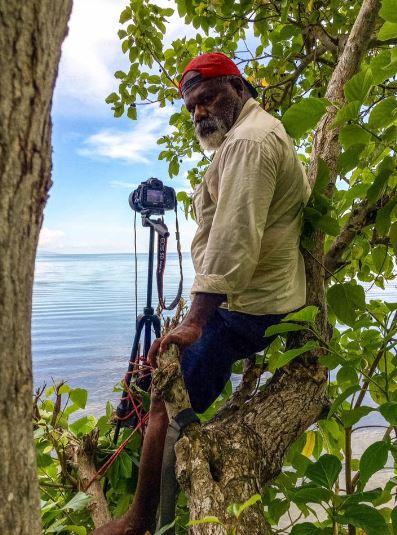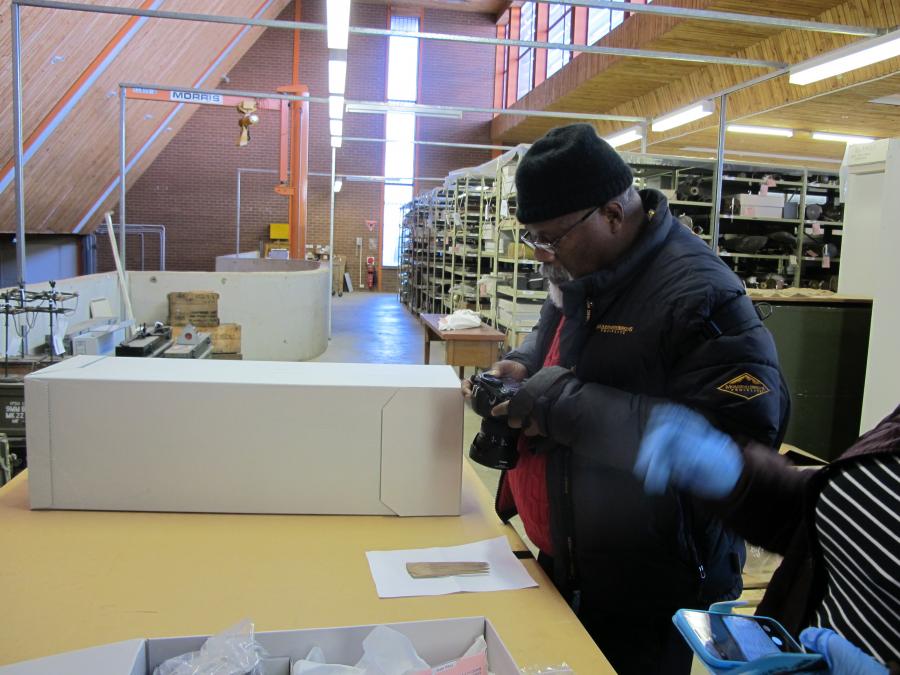Tributes flow for Gideon Kakabin

Gideon Kakabin has been described as an “epic pillar of historical knowledge”.
Picture from Gideon Kakabin's Facebook group, NGI Historical Society
Friends and colleagues have paid tribute to Gideon Kakabin, who died on 20 August 2018, as “a lantern of knowledge, history and wisdom” and an “epic pillar of historical knowledge”.
A passionate cultural historian and photographer who chronicled the independence struggle of Papua New Guinea, Kakabin was in Canberra to complete a four-week program as an artist in residence at the Australian War Memorial commemorating Australia and Papua New Guinea’s participation in the First and Second World Wars.
“I was asked to do it and, for me, it was just like a dream come true,” Kakabin said during an interview about the residency. “I have been able to meet some very serious researchers, and I don’t mean serious as in they don’t laugh, I mean serious as in they have some really important information that they have been able to give me. This place is a gold mine [and] every day has been good … There is always a discovery to be made here.”
Kakabin had a deep knowledge and understanding of the history and culture of his people, the Tolai of East New Britain, and was passionate about sharing that knowledge with others.
A Tolai Elder and Rabaul resident, he was strongly involved in the NGI Historical Society, and also led historical tours of the region.
As part of his residency at the Memorial, he was studying artwork relating to Papua New Guinea and was focusing on paintings by official war artist Charles Bryant that depict the township of Rabaul during the First World War.
He was particularly interested in the battle of Bitapaka, which took place more than 100 years ago on 11 September 1914. “The battle for Bitapaka was an engagement by Australian forces and the German colonial government in order to capture the wireless station at Bitapaka,” he said. “That was the first engagement, and it only lasted one day, but it was significant as far as Australian military history is concerned because it was the first engagement Australia was involved in, and the first engagement that Australian soldiers died in.”
Kakabin was also conducting research into the battle of Rabual in January and February 1942, and the impact of the Japanese occupation from February 1942 and the establishment of a Japanese garrison on the island.
“It was not really spoken about,” Kakabin said. “My mum never spoke about the war even though she lived through it. And my father never spoke about the war, even though he actually worked for the Japanese … as a sumo wrestler. I only found that out much later, after he died … But it wasn’t just my mother and father, the entire village never talked about it. In fact, the only people who talked about the war usually sang about the war … When they got drunk, they would start singing in Japanese.”
He shared the story of how villagers made a surprise discovery when they were pulling down an old church in 2006 to build a new one. “We all went to help and as we were digging up the foundation we found some caves underneath the whole church and we dug up these things – radio equipment, bicycles, batteries, bottles of sake and all this kind of thing – all underneath the church,” he said. “My mum was quite old then … and we went to her, and all she said was, ‘Oh, so that’s where all the roofing iron and things went to … after the war?’
“The Japanese had come and used their church as a headquarters, and when they were defeated they actually removed the roofing iron and dug a hole at the church and lined it with the roofing iron, and stored all their equipment in there.
“It’s bizarre and … everybody who lived through the war didn’t even know. The Australians had dropped the pamphlets that said that the war was done, and the next day the Japanese had disappeared. During the night they must have taken all this stuff and hidden it.
“But that’s just one story. The other story is that [when the Japanese left] the locals started crying as if they were really sad to see them go. I was interviewing this old man, and I said to him, why would they cry? One would have thought that it was the end of the war, and they would have been happy to see them go. He said they weren’t really crying because they were going to miss the Japanese, they were crying because they were not going to have access to rice, tinned fish, biscuits and sake anymore.”
It was stories like these, and Kakabin’s own family history, that helped spark his interest in history and his desire to learn as much as he could. “I started looking at the family tree and I just got more and more interested after that,” he said.
He went on to write a history of East New Britain from 1528 to 1994 and was involved in bringing a major exhibition of Papua New Guinea art to Australia.

Gideon Kakabin at work at the Memorial: "It was just like a dream come true."
For Kakabin, it was important to remember the past. He was a passionate ambassador for his country, working tirelessly to shed light on the history of New Guinea and the local culture.
“The war is part of it, and is obviously a serious part of it, but the culture is also quite interesting,” he said. “The culture determines who we are, and our relationship with [others] has been influenced by our culture … and by how other people see our culture.”
Kakabin died at the age of 62 after a short illness, and is survived by his wife Judy and his children, Tipia and Miriam.
Australian War Memorial Director Dr Brendan Nelson expressed his deepest sympathies. “He was loved and respected by the Memorial’s staff, who consider it a privilege to have worked with him,” Dr Nelson said. “His sudden death was both a deep shock and a tragic loss.”
The Chairman of the National Museum and Art Gallery of PNG, Julius Violaris, described Kakabin as a national treasure.
PNG political commentator and friend, Deni ToKunai, wrote on Facebook: “We have lost an epic pillar of historical knowledge today - not just in East New Britain, but in Papua New Guinea.
"Gideon touched many people with his historical, social and cultural commentaries. He was always open to listening to people share their stories - small and big - and enjoyed recording and documenting them.
"Gideon was at heart a story-teller. He loved PNG, East New Britain and the special history our little part of the world has. He dedicated much of his spare time and his own finances to pursue his passion and share it with the world.
"We have lost an epic pillar of historical knowledge ... Gideon at heart was a storyteller. He loved PNG, East New Britain and the special history our little part of the world has.”
In other online tributes, Matthew Cohen paid tribute to Kakabin as “a true gentleman and scholar”, and Kurai Crough called him “a lantern of knowledge, history and wisdom for those of us young Tolais still learning about our culture and history”.
Announcing the news on the the Papua New Guinea Association of Australia’s Facebook page, Andrea Williams said Kakabin was “more than special” and would always be remembered.
“He loved his family, he loved his people, he loved Papua New Guinea, he loved history, he loved all the stories … he just soaked it all in,” she wrote. “Gideon was passionate and fascinated with his homeland. He listened, he researched and he shared his extraordinary knowledge. He inspired anyone who would take an interest. Gideon knew that history brings us to where we are today and provides a foundation for the future … Gideon was always interested, appreciative, kind, thoughtful and generous. How can one person touch so many? We will miss him enormously.”